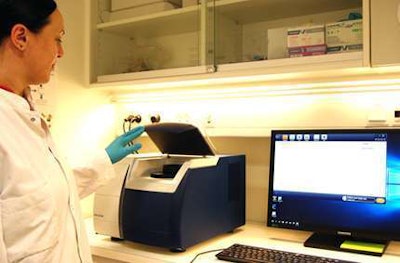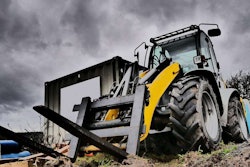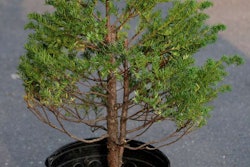 The sample cup is placed in the spectrometer for visible near-infrared spectroscopy measurement. The measurement takes approximately one minute and the spectrum is visualized on the computer screen for immediate quality check.
The sample cup is placed in the spectrometer for visible near-infrared spectroscopy measurement. The measurement takes approximately one minute and the spectrum is visualized on the computer screen for immediate quality check.Photo: Maria Knadel
Soil texture can make one of the biggest differences in the success of gardeners, as different plants require different air, water and nutrients to thrive.
When plants are able to grow in soil that has the correct texture, it’s easier to deliver the proper amount of fertilizer, water or pesticides that it might need, which ultimately helps them grow better.
With this in mind, research groups came together to explore the option of spectroscopy, which they say is a simple solution for soil sampling. These groups — the American Society of Agronomy, the Crop Science Society of America and the Soil Science Society of America — included scientists who specialize in different areas of soil science.
Since the traditional methods of analyzing soil were considered slow, Danish researchers found this new, high-tech method, spectroscopy, to be portable, cost-effective and fast. This technique, they say, could make it much easier to understand the soil texture of a particular area and in larger areas across the globe.
A combination of small mineral particles make up soil, and its texture is the most basic property that can be measured.
Mineral particles are grouped into three categories according to their size:
- The smallest particles are classified as clay. These microscopically tiny particles look like fine powder. They have a reactive surface area that can hold water, nutrients and salts.
- The particles in the next group, called silt, are not quite as small. They still look like powder but are not nearly as reactive as clay.
- The largest particles are sand. You can see individual sand particles with the naked eye. Sand has no reactive surface area, so it absorbs no water or nutrients.
The soil’s texture is defined by the amount of clay, silt and sand that’s present, and the texture determines how loosely or densely the soil is packed. The texture can also affect how fast water will drain from the soil after it rains.
Since soil geology and physics have different ways of defining the limiting sizes for the clay and silt fractions, the researchers decided to use technology that was already being used to study other soil properties.
Visible near-infrared diffuse reflectance spectroscopy, called vis-NIRS for short, is a method of measuring activity in the visible range and just beyond.
The sensors of the vis-NIRS can reveal differences in particle sizes due to the way they scatter light, and the researchers found that it can also provide detailed soil texture measurements that don’t depend on the definitions different scientists use to describe sand, silt and clay.
This technology, researchers say, can help gardeners and farmers by enabling them to take multiple soil samples and analyze them quickly in the field. Since relative amounts of silt, clay and sand can vary a lot on a single plot of land, researchers say these portable vis-NIRS sensors will prove an asset to gardeners and farmers.
“A landscape manager might want to grow a wide variety of plant species across a public park,” soil scientist Cecilie Hermansen of Aarhus University noted. “A map illustrating the different soil types can help the gardener choose the best plant species for different locations in the park.”
Hermansen collaborated with a team of scientists from Aarhus University and Aalborg University. Their work is published in the Soil Science Society of America Journal.










